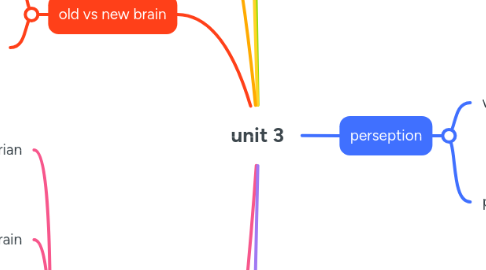
1. fondations
1.1. psychology
1.1.1. the study of the mind and behaviour
1.1.2. behaviour the actions and responses the we can observe
1.2. three levels of psychological study
1.2.1. biological
1.2.1.1. brain prosses and genetic influces
1.2.2. physchological
1.2.2.1. thought, feelings, and motives
1.2.3. enviromental
1.2.3.1. the past and the present enviroment we are exposed to
2. four lobes
2.1. frontal lobe
2.1.1. controls cognitionn, emotional expression, problem solving, memory, languge, jedgement, sexual behaviours.
2.1.2. prefrontal cortex
2.1.2.1. helps interact with world
2.1.2.2. left side is emotional
2.1.2.3. right side logic based analysis
2.1.2.4. last part of brian to developn
2.1.3. brocas area
2.1.3.1. language production
2.1.3.2. speach and language
2.1.3.3. form words
2.2. functions of the PFC
2.2.1. empathy
2.2.2. insight
2.2.3. respose reflixibility
2.2.4. emotional regulation
2.2.5. body regulation
2.2.6. morality
2.2.7. intuition
2.2.8. attuned comunication
2.2.9. fear modulation
2.3. parietal lobe
2.3.1. motor sensory skills
2.3.2. primary somatosensory cortex
2.3.2.1. sensations of heat, touch, cold, and sense of balence
2.4. temperal lobs
2.4.1. primary auditory cortex
2.4.1.1. langauges, sexuality, emotion, hearing and memeory
2.4.2. wernickes area
2.4.2.1. involved in language comprehension understand whats being said.
2.5. occipital lobe
2.5.1. primary visual cortex
3. organization of nervous sytem
3.1. central nervous
3.1.1. brian
3.1.2. spinal cord
3.2. peripheral nervous system
3.2.1. cranial nerves
3.2.2. all nerves to the rest of the body, including muscles and organs
4. old vs new brain
4.1. old focuses on the basic functions such as heart beat and breathing
4.2. new brain focuses on sensing, emotions, wanting, thinking, resoning
5. brian divison
5.1. hind brian
5.1.1. brain stem
5.1.1.1. medulla and pons
5.1.1.1.1. responsible for support life system
5.1.2. cerebellum
5.1.2.1. responsible for motor coordination
5.2. mid brain
5.2.1. midbrain has a major connection bettween the forebrain and the hind brian
5.3. fore brian
5.3.1. controls evreything
5.3.1.1. from voluntary movement to the integration of sensory information
5.3.1.2. higher abstract throught, logic, speach and emotions
5.3.1.3. this part of the brian is what sepperates humans form animals
5.3.2. cerebrum
5.3.2.1. largest part of brain
5.3.2.2. information processed
5.3.2.3. grey matter
5.3.2.4. cerebrum is diveded into 2 hemispheres by the corpus callosum
5.3.3. cerebral cortex
5.3.3.1. outer layer of neral tissue of cerebrum
5.3.3.2. makes up 80% of the brian tissue
5.3.3.3. not essential for phiscal survival
5.3.3.4. essentail for quality of living- attention, perception, awareness, thought, memory, language and consciouness
5.3.4. corpus callosum
5.3.4.1. connects the two sides of the brain
6. Limbic system
6.1. thalamus
6.1.1. relays information bettween the snesory system (which arre the five sences) to areas of the cerebla cortex for prosessing and interpretation
6.1.2. keeps you alert and focused
6.1.3. motor control
6.2. hypothalamus
6.2.1. regulation
6.2.2. homeostasis
6.2.2.1. keeps systems in balence
6.2.2.2. temperature control, hormonal balances, thirst/hunger, heart rate, breathing
6.3. amygdala
6.3.1. emotional processing areas of the brain
6.3.2. Amygdala attack
6.3.2.1. fight or flight response
6.3.2.2. signals are sent to prepare ypour body to fight or run away
6.3.2.3. it can happen whithout thinking-emotions take over instead of thingking clearly and calmly
6.3.3. gives emotional significance to situations (present and past)
6.4. hippocamous
6.4.1. important for
6.4.1.1. memory
6.4.1.2. learning
6.4.1.3. spatial navegation
6.4.2. connection with alzhimers
6.4.2.1. first spot to be affected
6.4.2.2. losses short term memory loss
6.4.2.3. hard time following directions
7. perseption
7.1. what is preseption and snesation
7.1.1. preception is making sense of what are sensis tell us
7.1.2. snesation how we take in information
7.2. preception is selective
7.2.1. by focusing on one thing and filtering out other incoming stimuli
